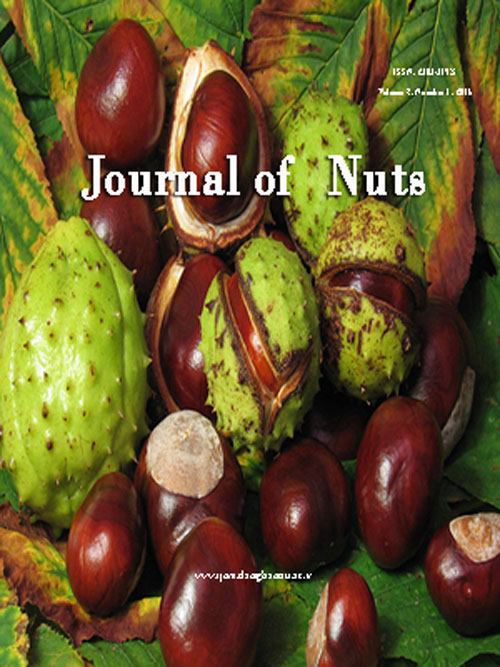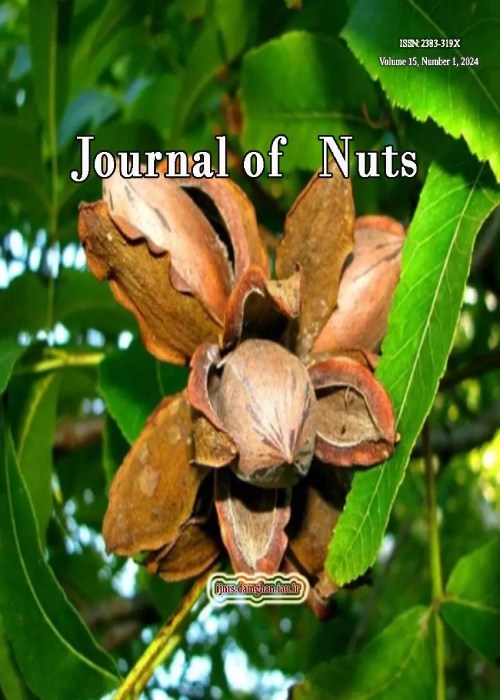فهرست مطالب

Journal of Nuts
Volume:12 Issue: 4, Autumn 2021
- تاریخ انتشار: 1400/09/10
- تعداد عناوین: 6
-
-
Pages 279-291Pistachio is one of the important horticultural crops, comprising 6.4% of the agricultural exports of Iran. In this study, the genetics of some early growth traits of 40 pistachio genotypes was evaluated under a greenhouse setting. The 40 genotypes were created by crossing eight male trees with five female individuals using the North Carolina I mating design. The experimental design was a completely randomized design (CRD) with three replications established in the greenhouse. Seedlings were assessed for stem height, number of leaves, roots, and shoot dry weight. The results revealed significant variation for the phenotypic traits assessed among the male parents. Male M6 had the lowest height among the genotypes. Males M4 and M2 had the highest and lowest number of leaves, respectively. The offspring of male M7 had maximum shoot and root dry weight. The offspring of females within males were significantly different. Regarding all studied traits of hybrids plants derived from (male M7×Fendoghi-48) had the highest height, leaf number and shoot dry weight. So M7 was the best male for mating and selection for good early seedling growth in pistachio because genotypes with a taller stem had better vegetative growth which can be used for producing rootstocks. For all studied traits, the amount of additive variance was greater than dominance variance, and shoot dry weight had the highest narrow-sense heritability (0.518) and the most expected relative genetic gain with 10% of selection intensity, indicating that the selection can be used to improve these early growth traits in pistachio.Keywords: Additive variance, Dominance variance, genetic gain, Genotypes, North Carolina, Vegetative growth
-
Pages 293-309The primary steps in breeding programs are identifying and selecting superior fruit trees genotypes. This study was conducted to achieve the most productive, self-compatible, and cold tolerated almond [Prunus dulcis (Mill.)D.A.webb] genotypes, by determining genetic variability of 103 progenies resulted by crossing ‘Tuono’ and ‘Shokoufe’ during two years, 2016-2017 at Meshkin Abad Horticulture Research Station in Karaj (50.9°E, 35. ° 7521 N, 1245 m height, with moderate and cold climates, shallow, calcareous soils, with a pH = 7) according to almond description (Gulcan, 1985) for selecting superior hybrids. The genetic relationship between selected hybrids was carried out by using genetic correlation. Minimum, maximum, and comparing mean results represented hybrids’ variability. Correlations indicated significant positive and negative variability. 20 components of effective traits justified 77.4% of the total variance. Hybrid separation was carried out by clustering analysis using 20 components. In 10th Euclidean distance, hybrids were separated into 17 groups. Fruit, nut, kernel, productivity, and vigor characteristics were the main factors in grouping clusters, respectively. In the first factor, traits including fruit size (0.70), fruit weight (0.880), fruit length (0.741), fruit width (0.769), fruit thickness (0.722), nut weight (0.872), nut length (0.729), nut width (0.795), nut thickness (0.673), kernel weight (0.849), kernel length (0.635) and kernel width (0.837). In the second factor, there were traits including productivity (0.797), number of nuts per tree (0.925), fruit weight per tree (0.932), and nut weight per tree (0.905). In the third factor, traits such as trunk diameter (0.60), the radius of expansion in two directions north-south (0.755) and east-west (0.804), leaf density (0.60), and growth habit (0.60). These third components could justify about 14%, 7%, and 5% of the total variance. The most variable traits were growth habit, high quality, bearing habit, flowering and leafing time, fruit size; date of harvesting, nut shape and the lowest variable trait was kernel taste.Keywords: Almond, breeding programs, Hybrid, Morphological traits, late frost spring
-
Pages 311-321This study was carried out in the Khatam, Yazd province, Iran from the beginning of 2014 to the end of 2015. Phenological traits and pollen properties of some male pistachio genotypes ‘A1’, ‘A2’, ‘A3’, ‘A4’, ‘A5’, ‘A6’, ‘A7’, ‘A8’, ‘A9’, ‘N1’, ‘Mh1’, ‘G1’, ‘M1’, ‘M2’, and ‘F1’ were surveyed. To find the effect of pollen source on the nut traits of the resulting seeds as well as the initial fruit set, Xenia and Metaxenia were evaluated. Moreover, pistillate flowers of the ‘Akbari’ cultivar were crossed with different pollen sources. Results showed that pollen germination of male pistachio genotypes was various. Among all of the pistachio male genotypes, the highest pollen germination percentage was obtained from ‘M1’ (92.66%) followed by ‘Mh1’ (86.66%) and ‘G1’ (86.00%). There were also significant differences between cluster and pollen weight of different pollen sources. Based on our findings, among the studied genotypes, ‘M1’ had the longest pollen tube 391.6 (μm), as well as the maximum pollen tube growth rate of 39 (μm h-1). The longest flowering periods were recorded to be 10 days in ‘M1’ and 7 days in ‘Mh1’, while the shortest period was 4 days in genotype ‘A5’ and ‘A3’. A significant correlation was found between pollen grain characteristics and initial fruit set, pistachio ounce, nut blanking, and as well malformed fruits. Based on the results pollens of genotype ‘M1’ decreased the nut blanking and malformed fruits in ‘Akbari’ cultivar, pollens of genotype ‘Mh1’ improved the pistachio ounce, and genotype ‘G1’ increased the initial fruit set.Keywords: Blanking nuts, Dichogamy, Open pollination, Pollen germination, Pollen tube
-
Pages 323-331Peanut is an oilseed plant, which is rich in seed oil and protein content. The effects of different irrigation methods and humic acid dosages were explored on yield and yield components of peanuts in Astaneh-ye Ashrafiyeh County in Guilan province, Iran, in 2018 and 2019 cropping years. The experiment was laid upon a split-plot design based on a randomized complete block design with three replications in which the main plot was assigned to irrigation treatments including rainfed treatment and irrigation to meet 60%, 80%, and 100% of water requirement, and the sub-plot was assigned to humic acid (HA) at four rates of 0, 3, 6, and 9 L ha-1. The results showed that the highest biological yield (9750 kg ha-1) was obtained from the plants irrigated to meet 80% of their water requirement and applied with 9 L ha-1 HA and the lowest (2453 kg ha-1) was produced under rainfed conditions with no HA applied. Seed yield was 1863 kg ha-1 at the 80% water requirement level and 2067 kg ha-1 at the HA level of 9 L ha-1. Based on the results, it can be recommended to apply 9 L ha-1 HA and supply 80% of the plants’ water requirement as appropriate conditions for the studied region.Keywords: Humic acid, Irrigation, Peanut, Seed yield
-
Pages 333-360Drought is one of the main important adverse environmental events, certainly has an impact on plant growth and development. Pistachio is cultivated in areas where soil water deficits and salinity conditions are higher than normal. In most orchards, deficit irrigation is a common practice. There is only limited understanding of the physiological mechanisms pistachio uses to survive in drought. Many adaptive strategies have been developed in plants for dealing with water stress. The objective of the present study was to evaluate the effect of drought stress on the photosynthetic, physiological and biochemical parameters in one-year-old seedlings of 12 pistachio hybrids. Therefore, a greenhouse experiment was carried out to assess the effects of two drought stress treatments (drought stress and full-irrigation) for 40 days with a subsequent two weeks’ recovery period and several parameters (pigments (total chlorophyll, anthocyanins and carotenoids), internal CO2 concentration (Ci), chloride (Cl-) ions and fluorescence parameter) were evaluated at four different times (beginning, middle and end of stress and then recovery). After the end of the stress period, the seedlings were irrigated for two weeks. Results revealed that the drought stress treatments led to a change in the studied parameters and the mechanism of drought tolerance was variable at different times. Pistacia atlantica hybrid, P. vera “Sarakhs” and P. vera “Shasti” hybrid rootstocks had the highest water use efficiency; P. vera “Sarakhs” hybrid, P. vera “Khanjari” hybrid and P. vera “Badami” hybrid had the highest Cl- and mesophyll efficiency. P. atlantica and P. vera “Khanjari” had the highest anthocyanins and carotenoids. P. vera “Shasti”, P. vera “badami”, P. mutica and P. mutica hybrid rootstocks have been able to withstand drought stress by increasing the amount of K+ ion and maintaining gas exchanges. The results also showed that the response of the rootstocks to rehydration was different. Seedlings that recovered well after rehydration had a higher tolerance threshold. The “Khanjari” cultivar was recovered better than the others.Keywords: Drought stress, Multivariate analysis, Pistachio hybrids, Rehydration
-
Pages 361-370Pistachio hull, as the dominant component of pistachio processing wastes, is a source of phenolics with antioxidant properties. Extracting these compounds from pistachio wastes has recently attracted a lot of attention. The current study aimed to identify the optimal conditions for extracting phenolics from pistachio hulls. Firstly, some parameters such as different sample to solvent ratios (1:10, 1:20, and 1:40), extraction temperatures (25, 45, and 65°C), and duration times (1, 2, and 3 h) were evaluated under extracting solvent of water. The content of total phenolics and antioxidant activity were determined using spectrophotometric methods. The results indicated that the highest phenolics (~35 mg g-1) were extracted at 2 h extraction time, 65 °C, and the sample to solvent ratio of 1:10 (optimum condition by the solvent of water). Secondly, other organic solvents of ethanol, methanol, and acetone 50% were evaluated to identify the best solvent under optimal conditions. All of these organic solvents were more efficient than water in extracting total phenolics (with antioxidant property) from pistachio hulls. However, the highest amount of total phenolics (~47 mg g-1) was extracted by ethanol. Optimizing the extraction of phenolic compounds from pistachio hulls would be important in terms of reducing human and environmental risks caused by the waste accumulation, as well as producing naturally beneficial compounds and using them instead of synthetic antioxidants in the human diet.Keywords: Antioxidant, Pistachio hulls, Total phenolics, Wastes


